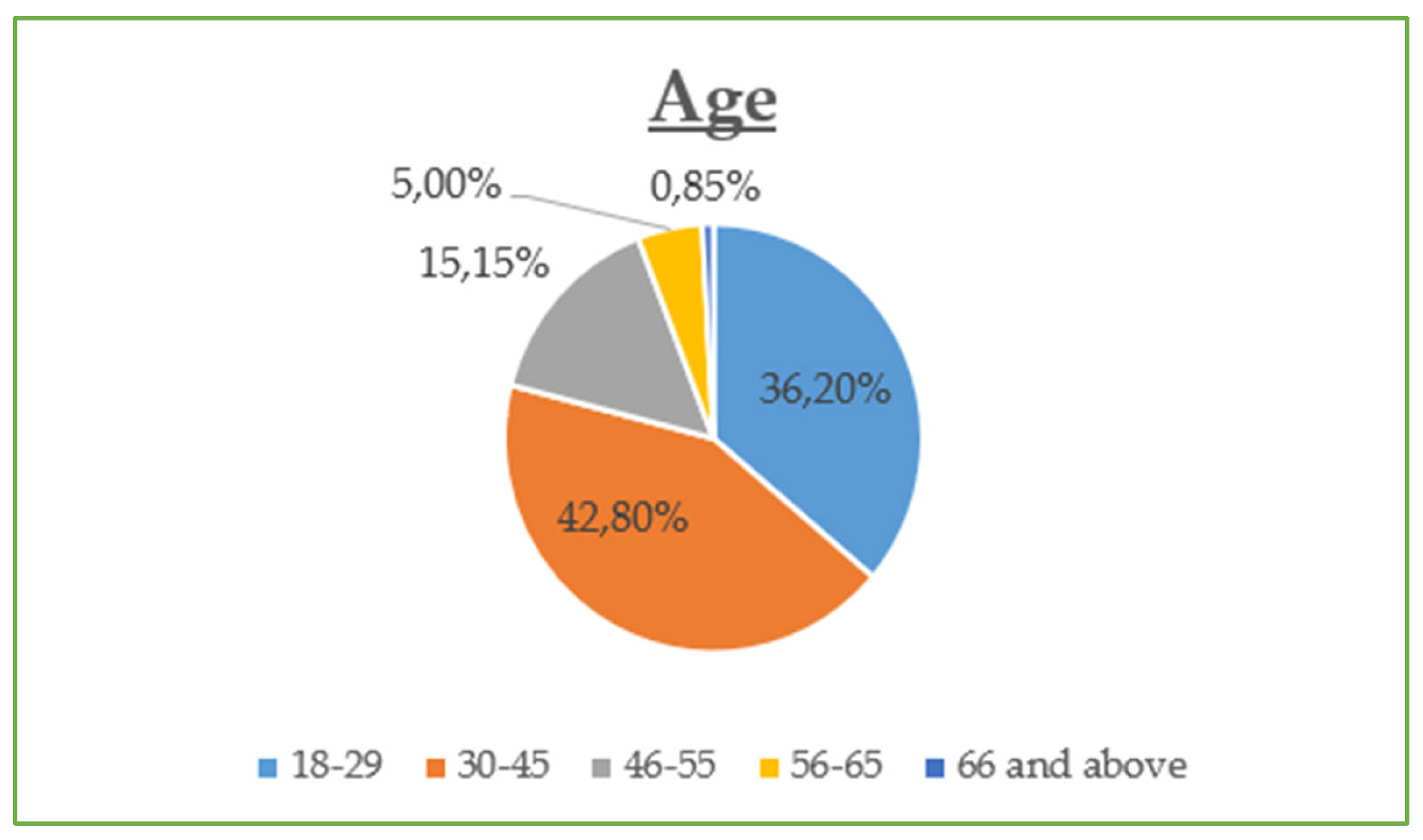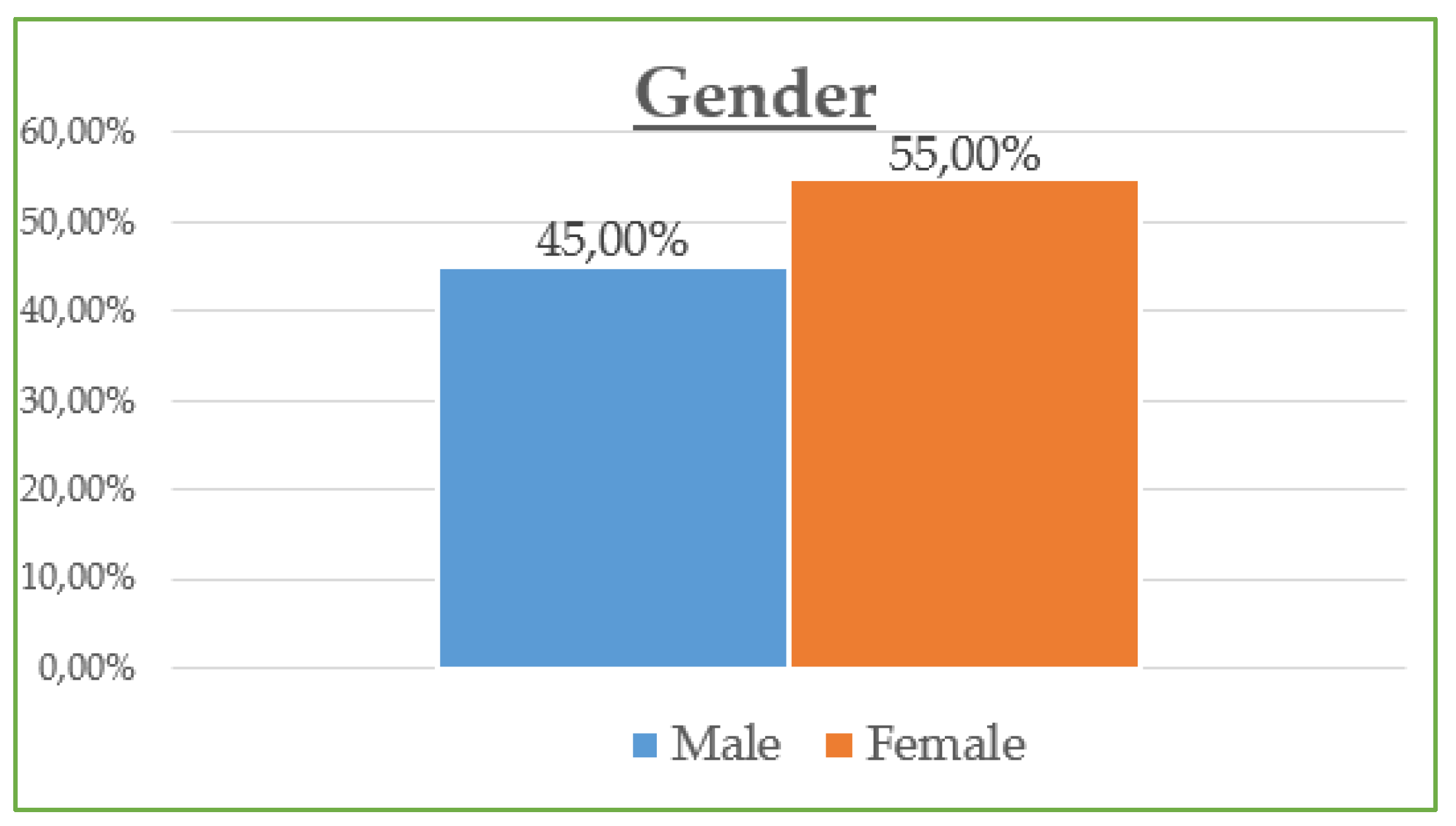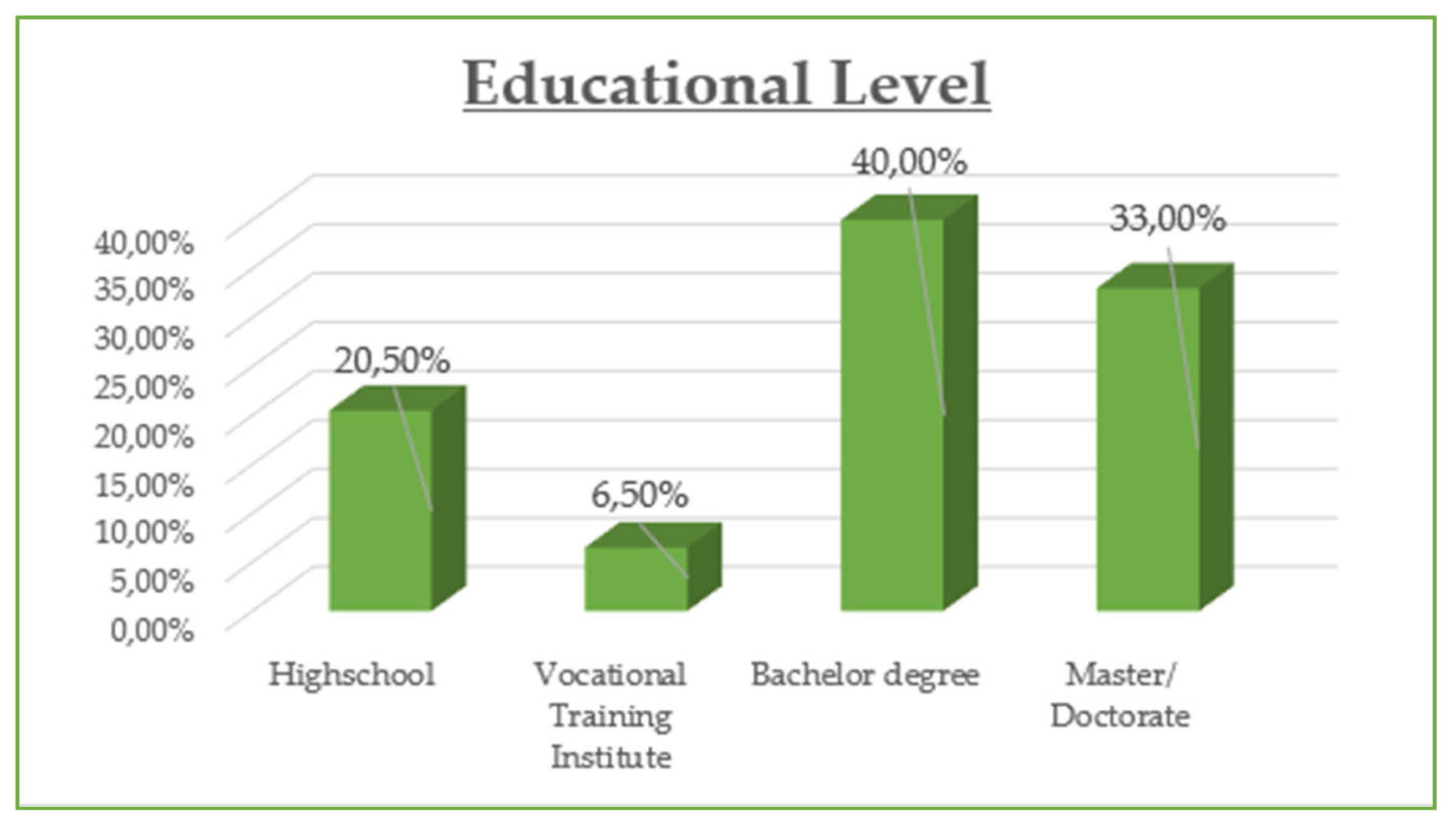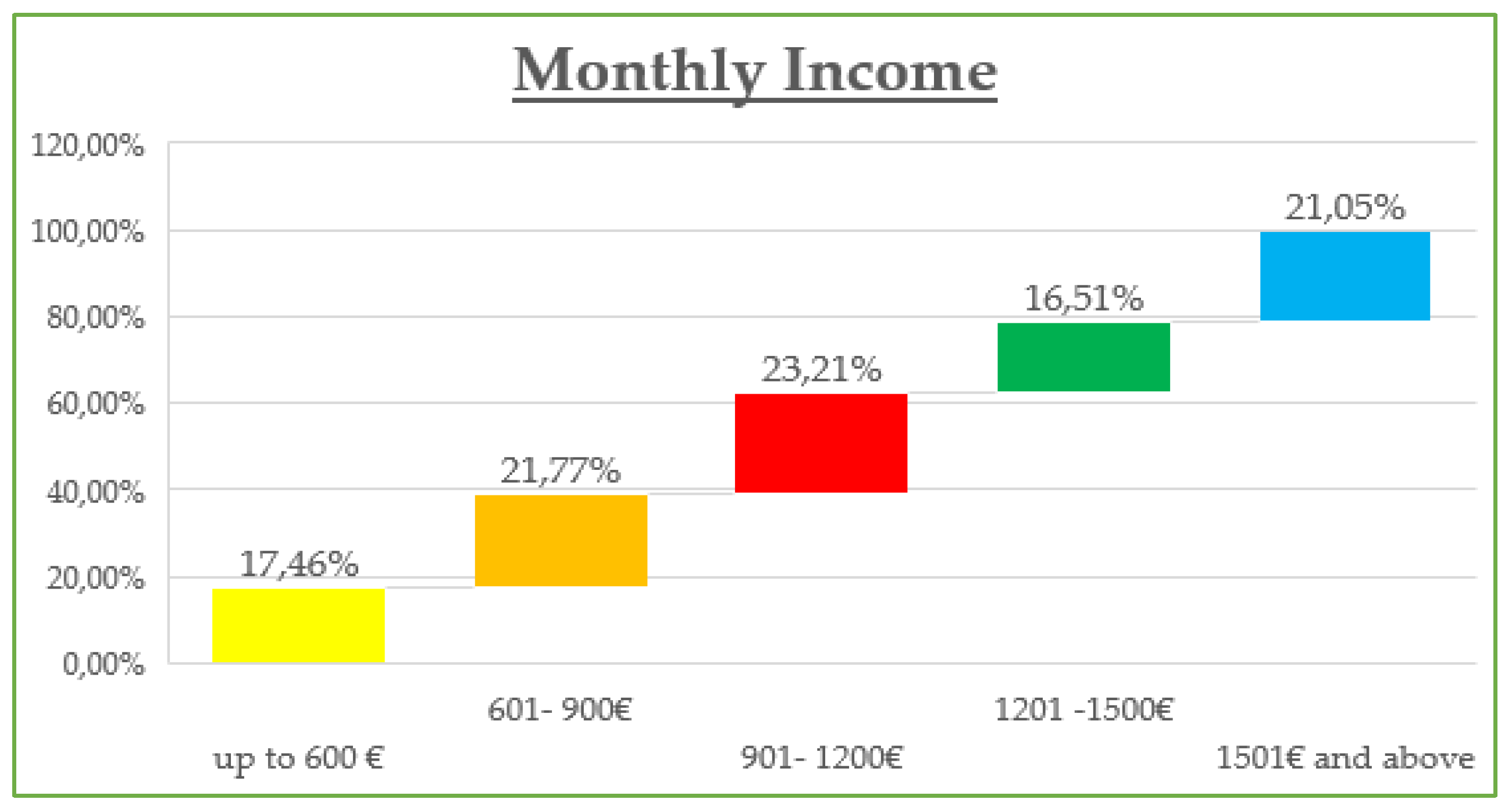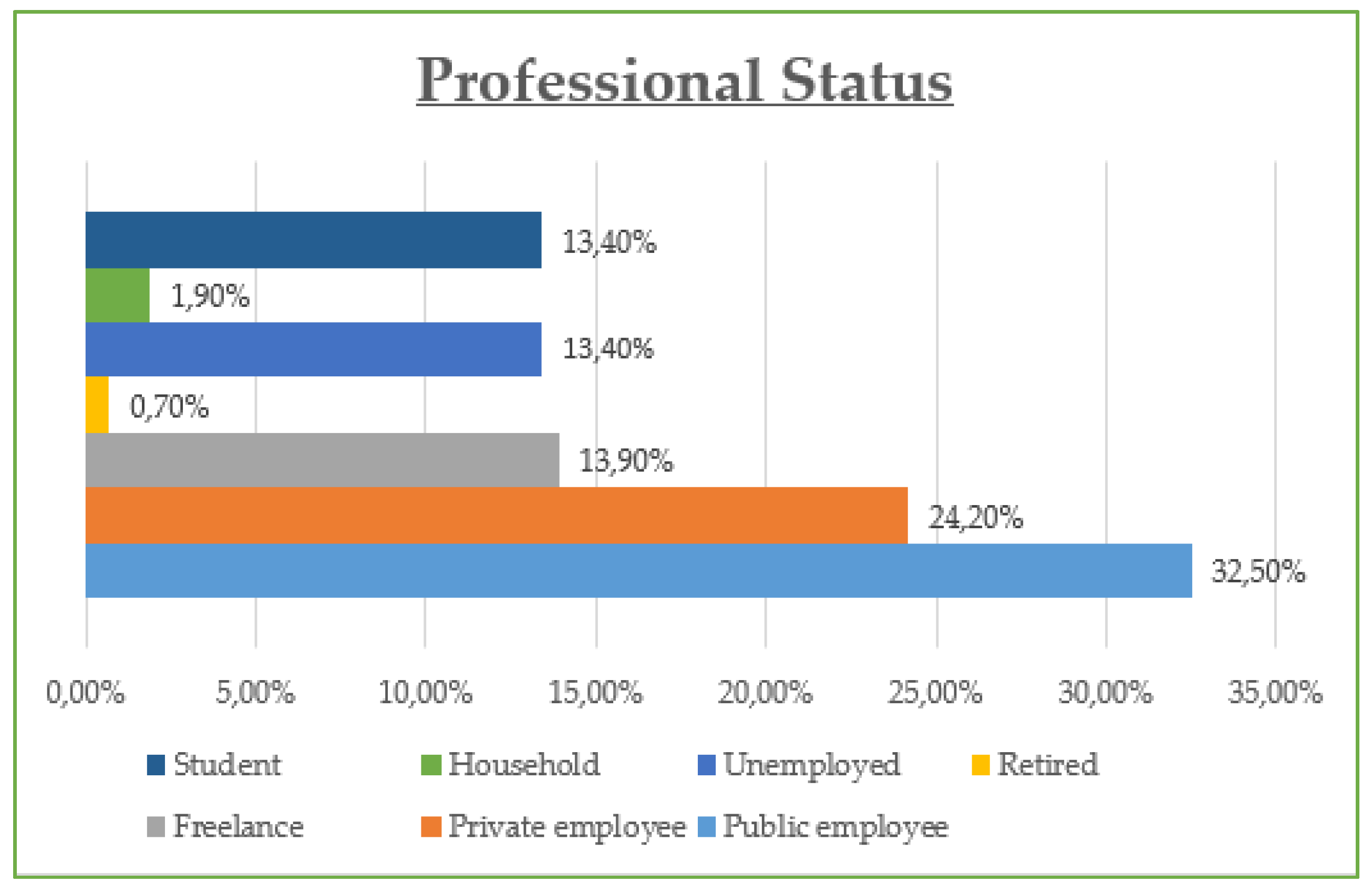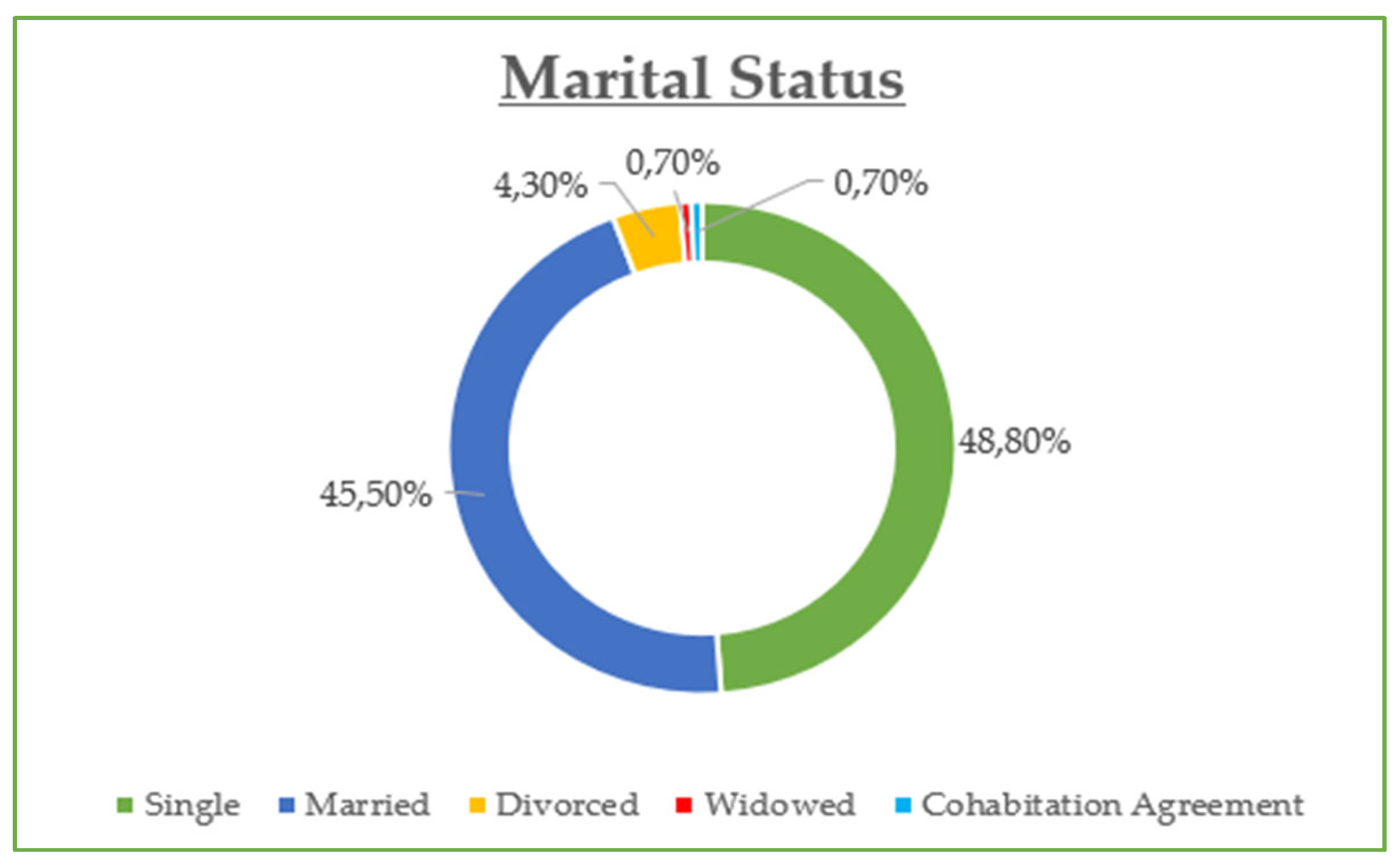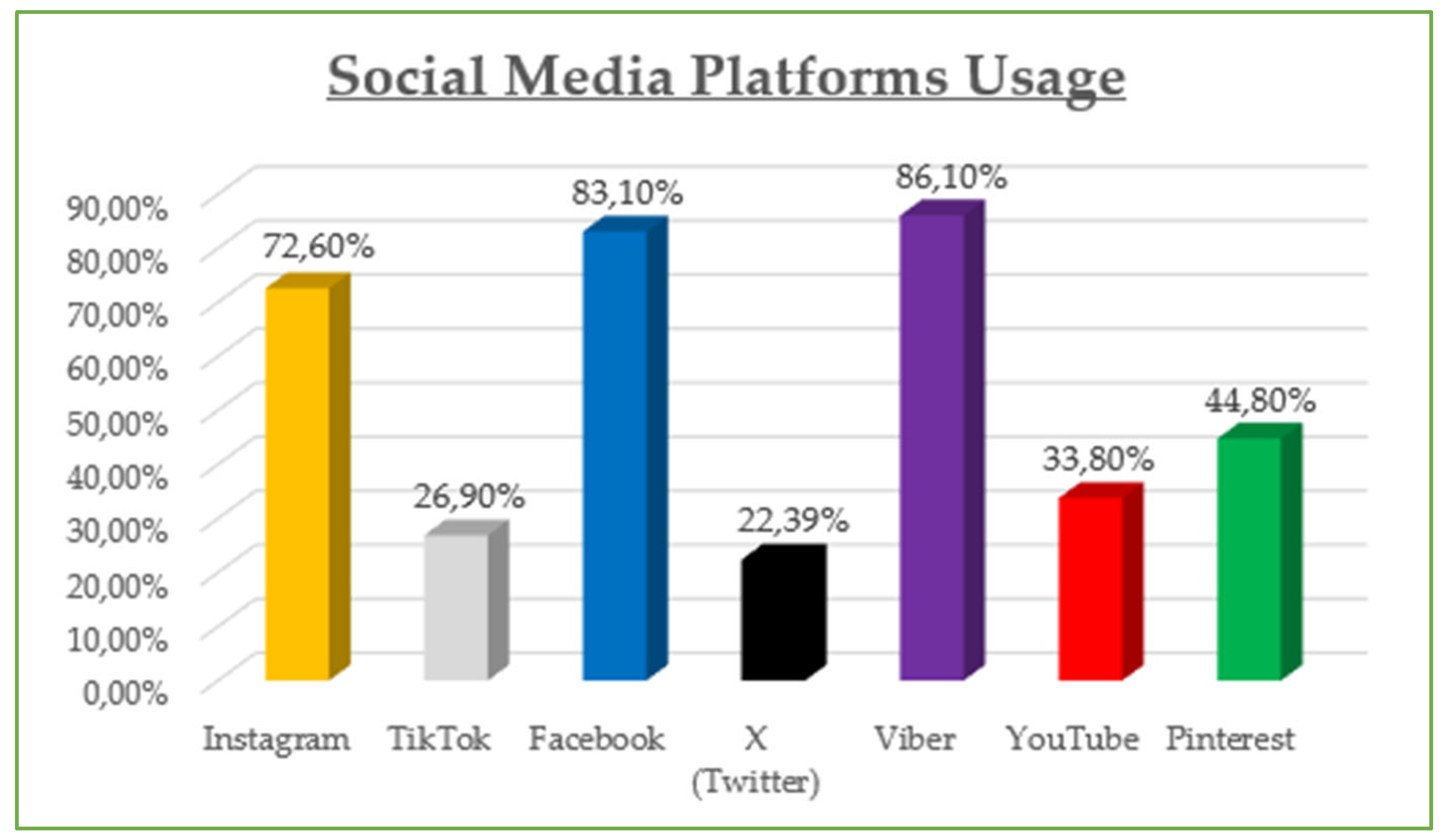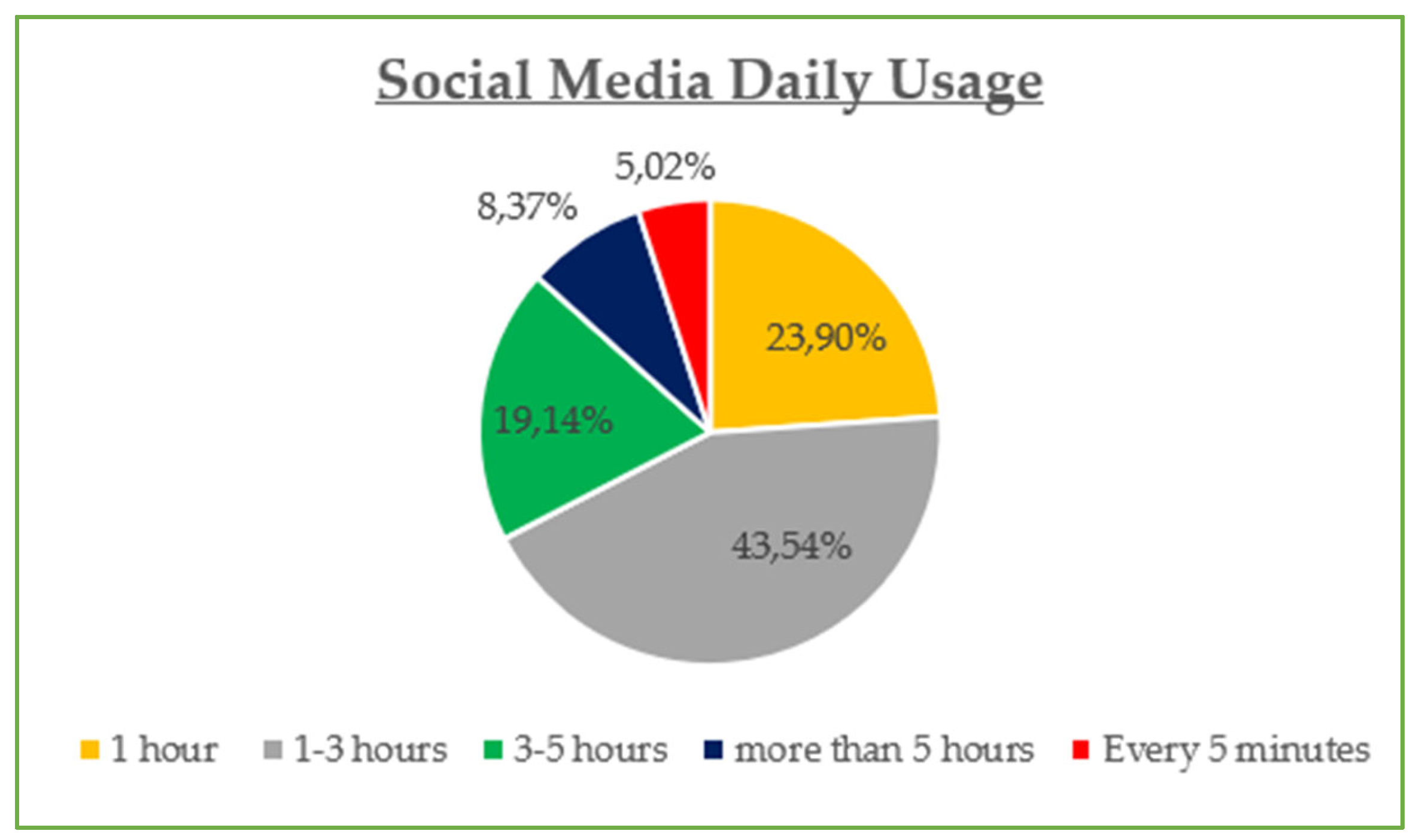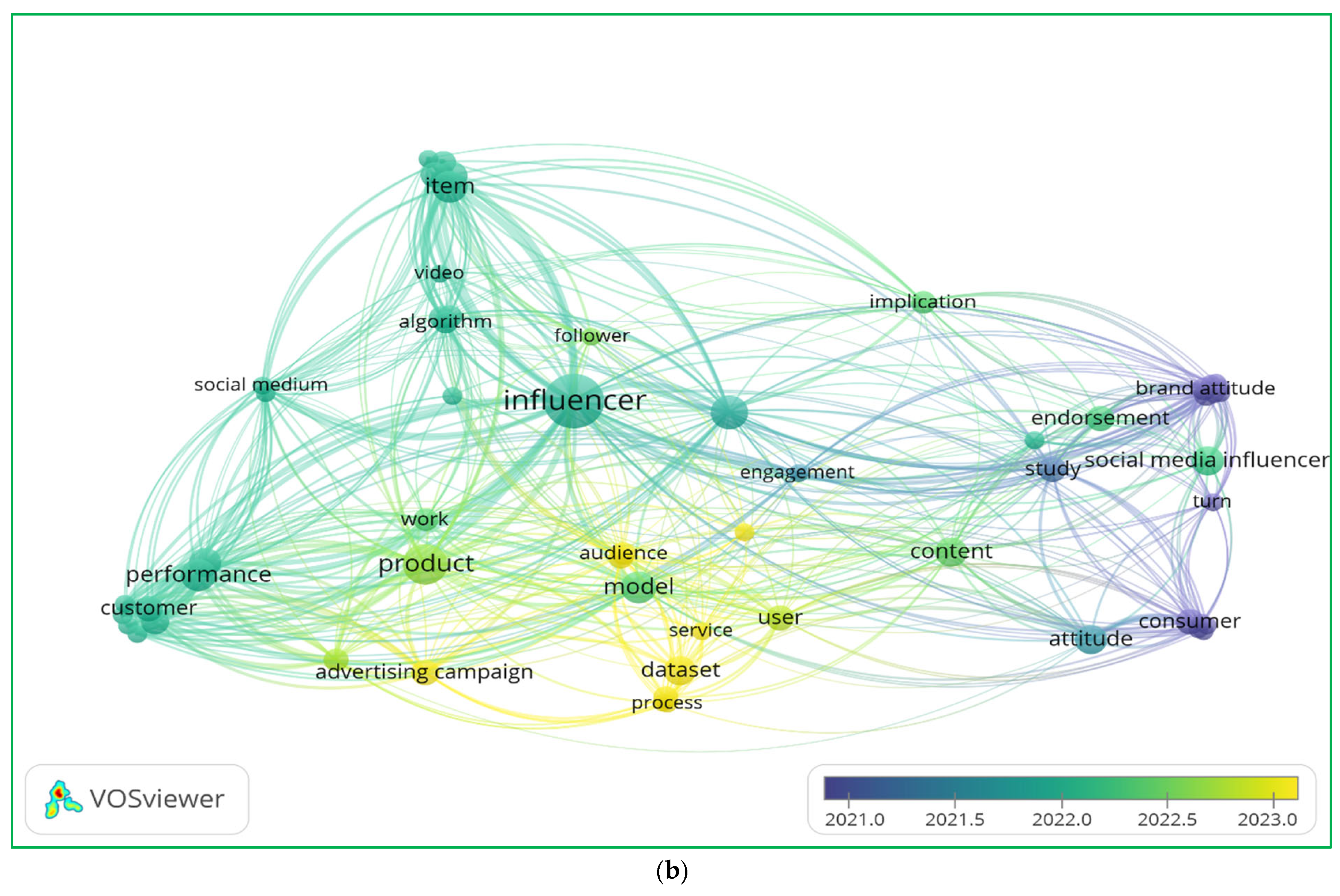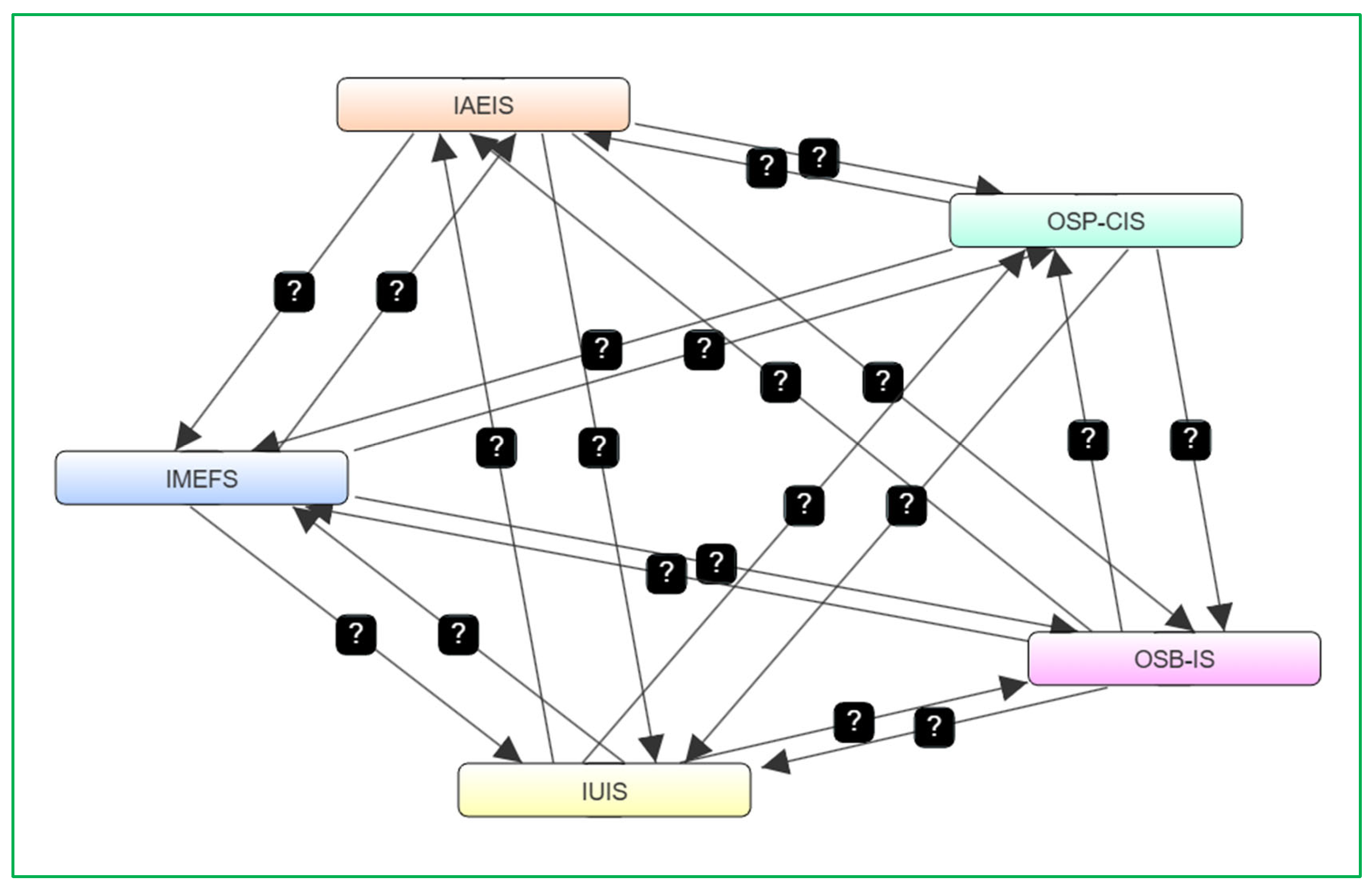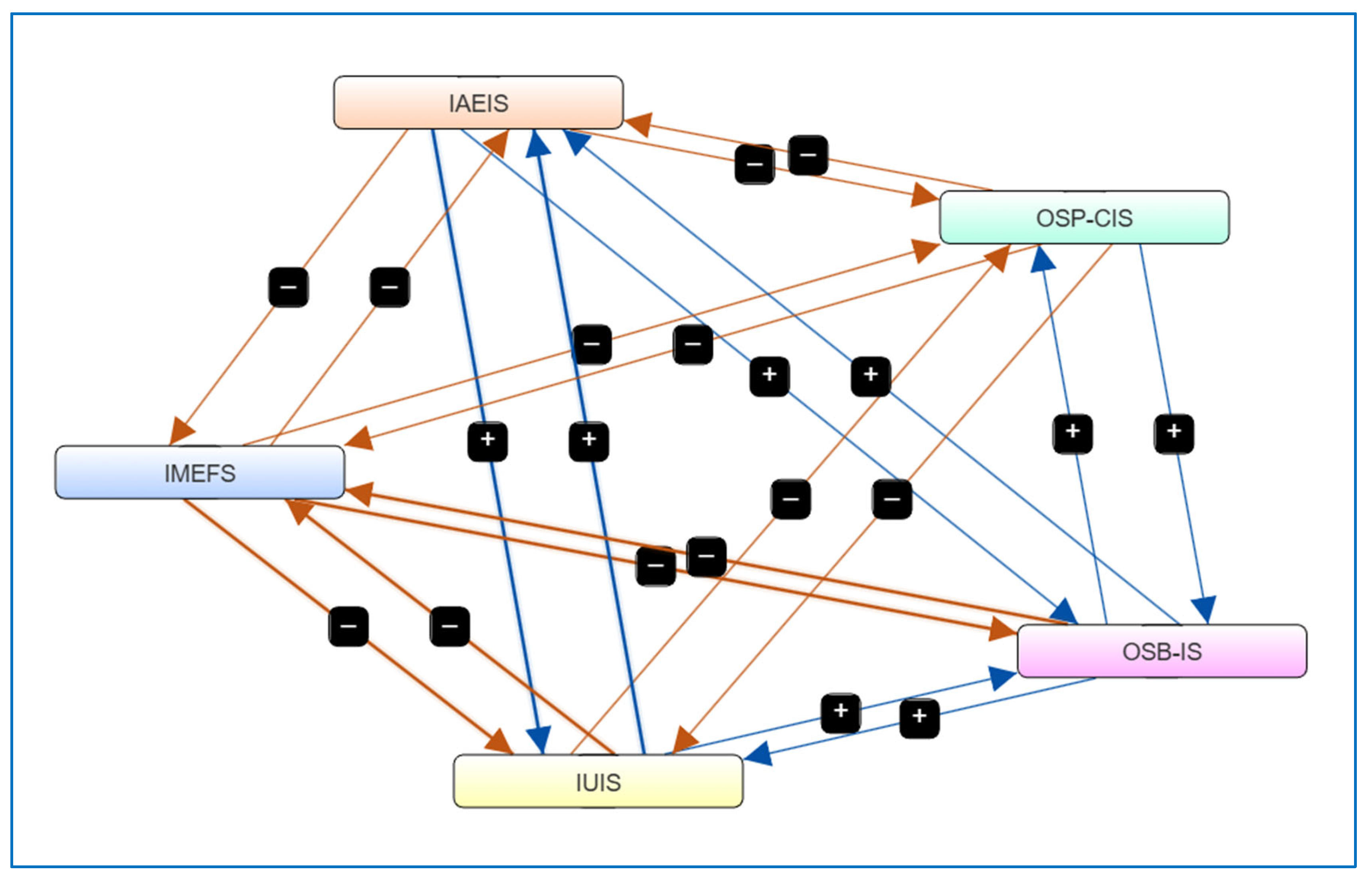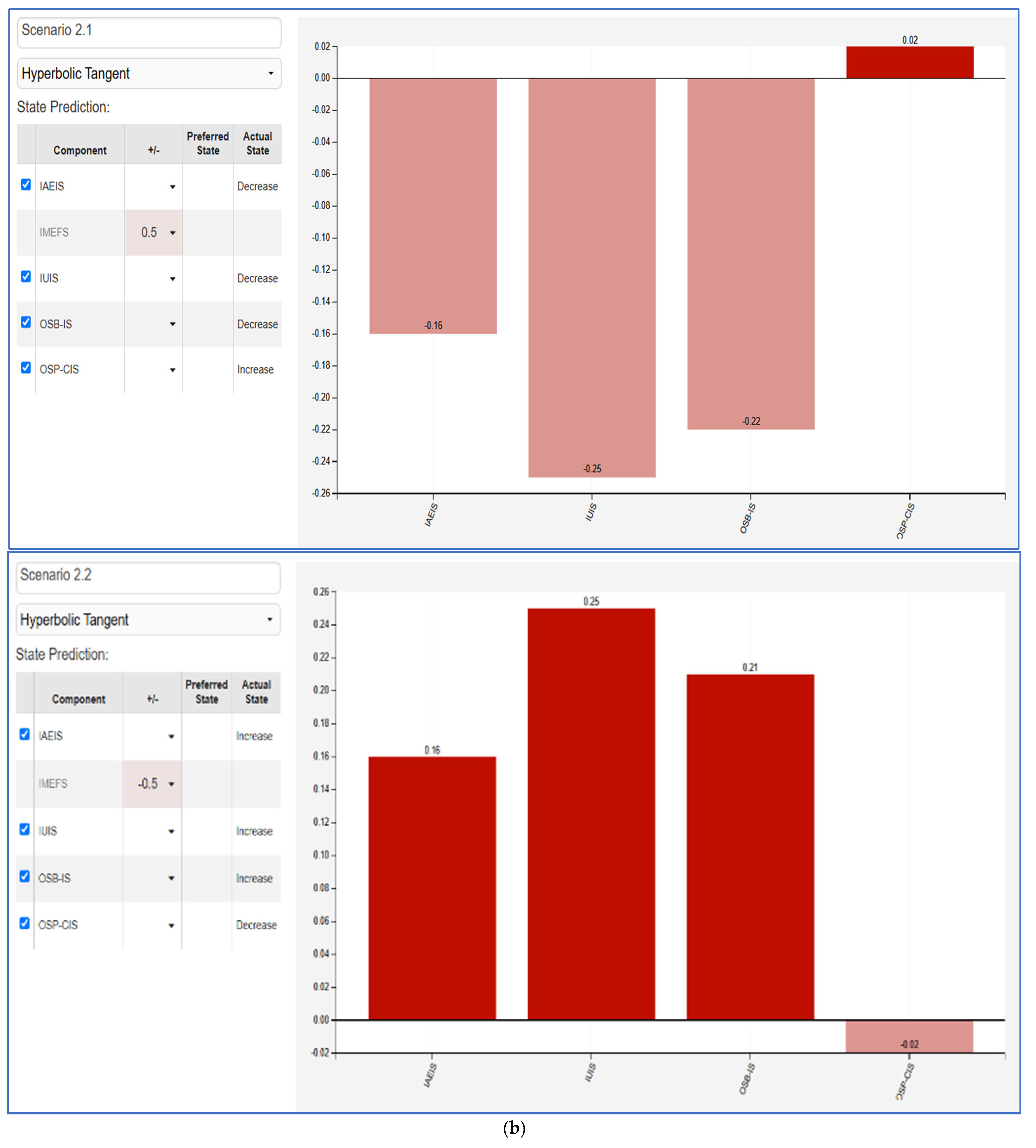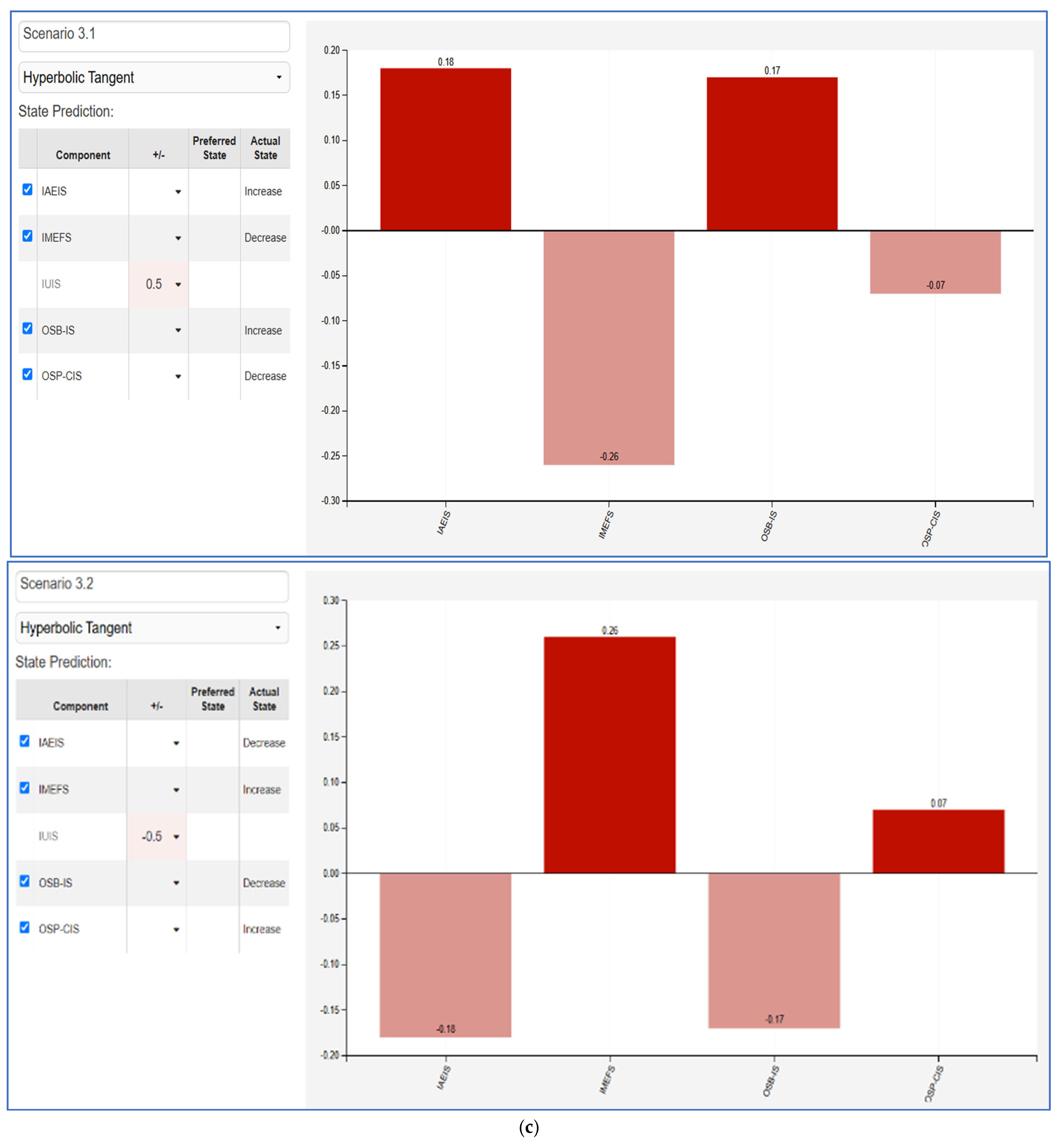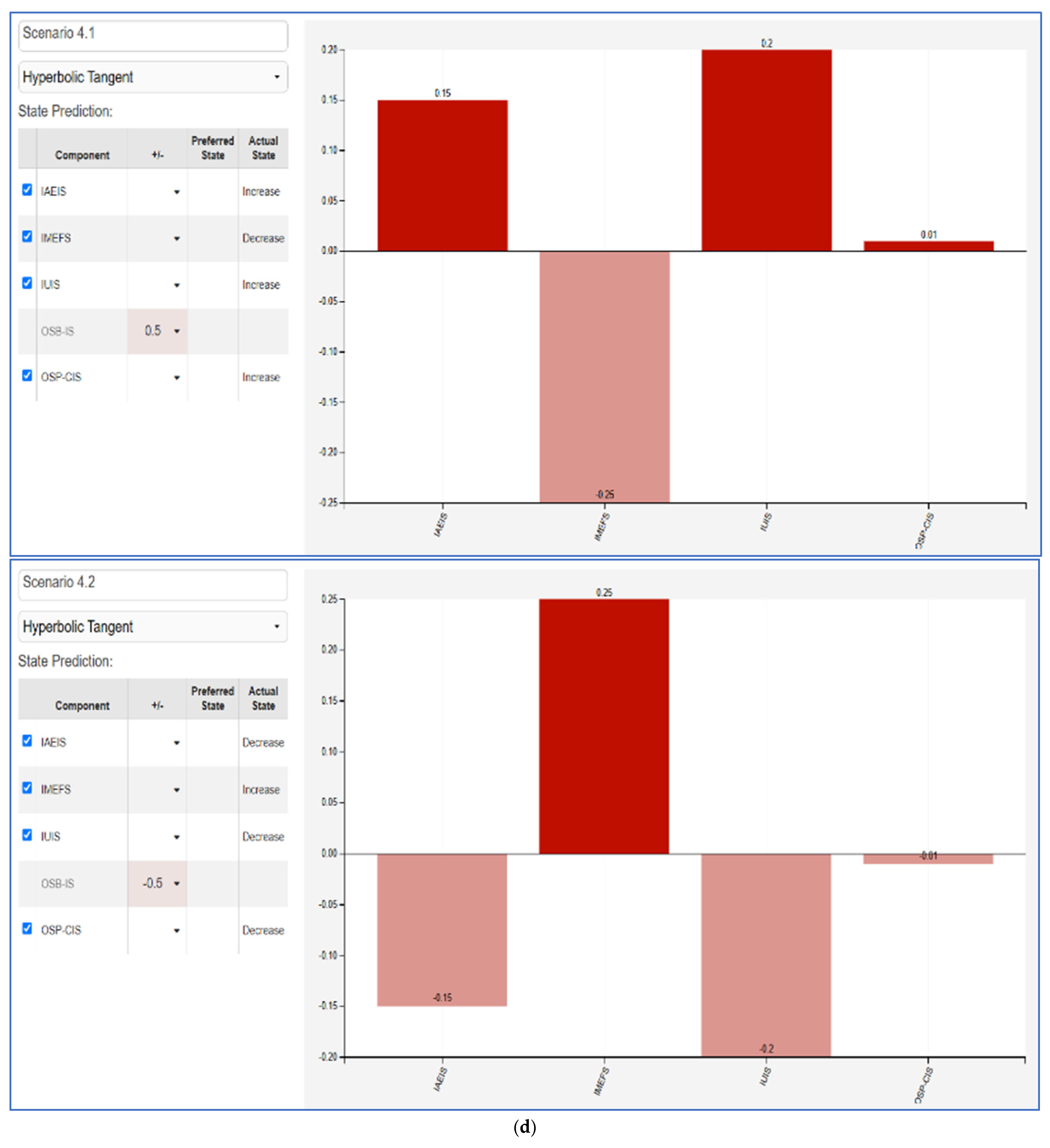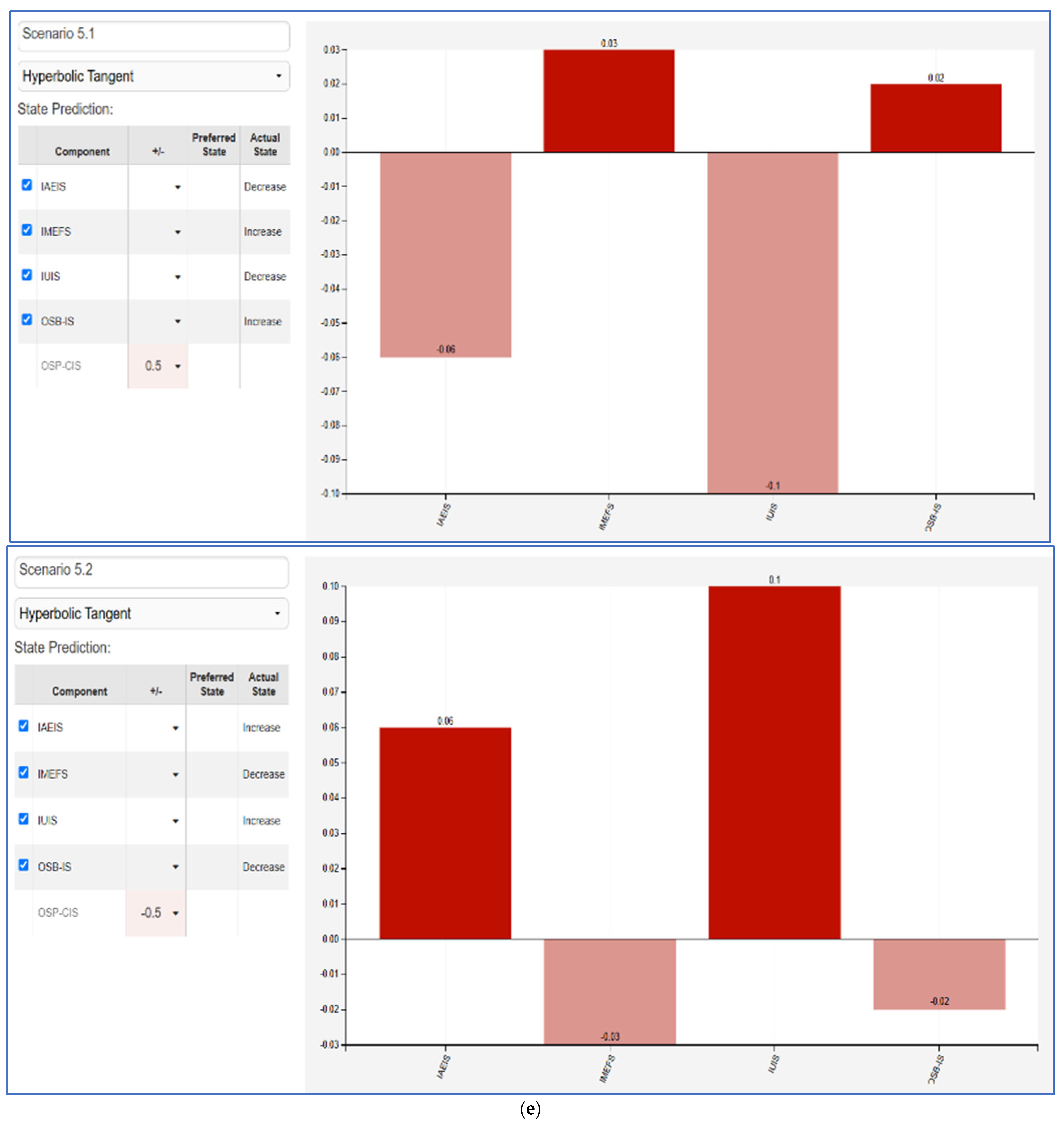1. Introduction
The interpersonal contacts that develop satisfy people’s social needs for personal contact, and through interaction, the individual becomes able to maintain his/her social identity while receiving emotional support. Marketing is the activity, set of institutions, and processes that lead to the creation, communication, delivery, and exchange of offers for the purchase of products and services, which have value for the consumer public and society in general [
1]. The main challenge for an online business is to make customers feel special, which can be implemented through digital marketing.
In the evolving landscape of digital marketing, social media and influencer marketing have emerged as pivotal forces reshaping consumer behavior. Social media platforms, with their vast reach and interactive capabilities, have become central to modern marketing strategies [
2]. Influencer marketing, a subset of this digital realm, leverages the credibility and reach of popular individuals to shape consumer perceptions and drive purchasing decisions [
3]. As influencers establish themselves as trusted voices within their niches, their endorsements and content play a significant role in influencing their followers’ attitudes and behaviors [
4]. Understanding how these dynamics unfold requires a closer examination of the relationship between social media, influencer marketing, and consumer intentions.
Calderón et al. [
5] emphasized that understanding the consumer behavior of a company’s clients is very important. Thus, companies should offer personalized shopping experiences while simultaneously improving both their services and products. Trudel [
6] argued that consumer behavior is determined by external and internal factors, with external factors including terms such as accessibility, availability, and affordability of the product, that is, the products available for purchase and the products that customers can afford to buy.
Consumer behavior in the digital age is increasingly intertwined with social media marketing strategies. The rise of social media has transformed how consumers interact with brands, shifting the focus from traditional advertising methods to more personalized and engaging content [
7]. Social media platforms provide a space for consumers to seek recommendations, reviews, and endorsements from influencers whom they perceive as authentic and relatable [
8]. This shift has led to a growing interest in understanding how social media marketing impacts consumer decision-making processes. By exploring how consumers respond to influencer marketing efforts, researchers can gain insights into the effectiveness of these strategies and their influence on purchasing intentions [
9].
The integration of digital marketing strategies with influencer marketing further underscores the need for research in this area. Digital marketing encompasses various online techniques and platforms designed to reach and engage target audiences [
10]. Influencer marketing, as a specialized form of digital marketing, leverages influencers’ established relationships with their followers to enhance brand visibility and credibility. This approach has proven effective in driving consumer engagement and sales, making it essential to analyze its impact on consumer intentions. Investigating how influencer marketing campaigns affect consumer perceptions and behaviors can provide valuable insights for businesses seeking to optimize their digital marketing strategies and achieve better outcomes [
11].
Given the increasing reliance on social media and influencer marketing in shaping consumer intentions, a comprehensive study is crucial to uncover the nuances of this relationship [
12]. By examining how influencer marketing influences consumer intentions and decision-making, researchers can contribute to a deeper understanding of its effectiveness and strategic value [
13]. This knowledge will not only benefit marketers aiming to refine their approaches but also provide consumers with a clearer perspective on the role of influencers in their purchasing decisions. As the digital marketing landscape continues to evolve, exploring the impact of influencer marketing on consumer intentions remains a critical area of inquiry.
The remainder of this paper is organized as follows: The present section presents an extant literature review of the examined topic. In the next section, the Research Methodology is discussed along with the formulation of the research hypotheses. Moreover, the development of the questionnaire and the study sample are also presented.
Section 3 presents statistical analyses of the collected data to verify, or not, the research hypotheses, as well as the development of the Fuzzy Cognitive Mapping (FCM) scenarios. Finally, this paper concludes with the Discussion and Conclusions section, which offers clear insights and suggestions regarding the study’s findings and its limitations.
2. Literature Review
Influencer marketing has evolved into one of the most effective tools for digital engagement, surpassing traditional marketing methods in terms of consumer trust and ROI [
14]. In 2023, the global influencer marketing industry was valued at
$21.1 billion, more than doubling since 2019 [
15]. This growth reflects a shift in consumer preferences toward peer-endorsed content, with nearly half of social media users making purchases influenced by influencer recommendations [
16]. The effectiveness of influencer marketing lies in its ability to provide authentic, relatable content that resonates more than conventional digital ads, which are often perceived as intrusive [
17].
Compared to traditional digital marketing, such as email campaigns, display ads, and search engine optimization, influencer marketing offers stronger emotional engagement and audience segmentation. While traditional strategies offer broad reach, influencers foster more personalized, trust-based interactions [
18]. According to Beichert et al. [
19], influencer marketing yields up to 11 times higher ROI than banner ads, due to increased click-through rates and higher conversion stemming from influencer credibility. Moreover, brands using micro- and nano-influencers report more loyal followings and niche-targeted results, challenging the one-size-fits-all logic of traditional approaches [
20].
Several emerging trends define the current influencer marketing ecosystem. First, the rise of nano-influencers (under 10,000 followers) provides businesses access to niche markets with highly engaged audiences [
21]. Second, long-term partnerships are replacing one-off collaborations to ensure continuity and trust between influencers and audiences [
22]. Third, content diversification—especially in the form of short videos, livestreams, and behind-the-scenes reels—is improving campaign versatility [
23]. Brands must also manage the balance between authenticity and promotional messaging. Excessive sales-driven content often results in ad fatigue and diminished trust [
24], whereas value-driven storytelling is more likely to cultivate engagement [
25].
As influencer marketing matures, ethical transparency becomes critical. Recent enforcement by regulatory agencies, such as the FTC’s 2024 mandate on disclosing sponsored content, emphasizes the importance of transparency [
26]. Fake endorsements and undisclosed promotions now risk legal consequences, pushing influencers and brands to prioritize authenticity and accurate representation. Additionally, ethical practices influence campaign performance, as studies reveal that perceived honesty in influencer content significantly impacts consumer trust and purchase intention [
27]. Ethical guidelines also vary across regions, suggesting a growing need for international harmonization of digital advertising regulations [
28].
Table 1 below presents the literature review of the most recent and relevant studies. The research gap in the literature can be discerned and directly compared with our study. Based on these findings, the main research objective is settled.
Influencer marketing and online shopping behaviors have emerged as dominant forces shaping consumer decision-making and digital marketing strategies. While existing studies, such as those by Hudders and De Jans [
30] as well as Li and Peng [
31], have explored aspects like influencer trustworthiness and gender-specific effects, there is limited understanding of how influencer marketing impacts industries or demographics differently. Similarly, works by Aw and Agnihotri [
32] and Cheah et al. [
37] have highlighted challenges like over-endorsement and authenticity but have not sufficiently addressed the interplay between consumer engagement quality and industry-specific marketing effectiveness.
Furthermore, while Zhang et al. [
33] and Sánchez Villegas et al. [
36] have introduced simulation models and multimodal analyses, their practical application remains untested, particularly in real-world shopping behaviors across categories such as health, beauty, and technology. The literature often treats consumers as a homogeneous group, overlooking behavioral and demographic variations that influence satisfaction and loyalty in online shopping, as noted by Lopez-Dawn and Giovanidis [
35].
Additionally, Doshi et al. [
34] and Antoniou [
38] have explored the theoretical implications of transparency and regulatory compliance in influencer marketing, yet these discussions lack empirical evidence to substantiate their impact on consumer trust and long-term engagement. Lastly, there is insufficient exploration of how technological advancements like AI personalization and augmented reality can mitigate concerns about product quality and foster continued online shopping.
The following graphs (
Figure 1) illustrate a bibliometric analysis of the literature on influencer marketing and social media strategies. The visualization highlights the clusters of relationships, key terms, and temporal trends in the field.
The analysis of the keyword co-occurrence figures highlights three key themes shaping influencer marketing research. First, technological advancements, such as algorithm-driven influencer selection, AI-enhanced content strategies, and video-based engagement, are increasingly central to digital marketing [
39,
40]. Second, consumer behavior and engagement dynamics play a pivotal role, as evidenced by the strong connections between brand attitude, social media influencers, and audience response metrics, reinforcing the need for content personalization and interactive consumer experiences [
41,
42]. Lastly, performance-driven influencer marketing strategies emphasize advertising campaigns, product visibility, and dataset-driven optimization, demonstrating the importance of data analytics in measuring influencer impact [
43,
44]. These insights suggest that future influencer marketing success will rely on AI-powered strategies, consumer-centric content, and precise performance tracking to enhance brand engagement and sales conversion. This paper aimed to bridge critical gaps, offering deeper insights into the interplay between influencer marketing strategies and consumer behavior.
Therefore, the research objective (RO) of the present research is: “to examine the multidimensional impact of influencer marketing, social media engagement strategies, and online shopping behaviors on consumer satisfaction, loyalty, and purchasing decisions across industries, demographics, and technological contexts”.
This study aimed to fill the identified gaps by:
Examining the industry-specific and demographic variations in the effectiveness of influencer marketing activities, moving beyond the generalized findings of prior research.
Exploring the qualitative dimensions of social media engagement strategies, such as authenticity and content quality, and their role in driving consumer satisfaction and loyalty.
Assessing behavioral segmentation in shopping categories (e.g., health, beauty, and technology) to provide actionable insights for marketers in tailoring strategies.
Integrating technological advancements such as AI-driven personalization and virtual try-ons into the analysis of online shopping behaviors, addressing concerns about product quality, and improving satisfaction.
Providing empirical evidence on the dual nature of influencer marketing—both its benefits and challenges—and how it impacts consumer trust, loyalty, and purchase decisions.
By addressing these gaps, this study contributes to the ongoing discourse on digital marketing and consumer behavior, offering a nuanced understanding that bridges theoretical concepts with practical applications.
2.1. Social Media and Influencer Marketing
Social media platforms have transformed into powerful mass media channels that enable the dissemination of news and information on an unprecedented scale through user interaction. These platforms allow individuals to stay connected more frequently and intimately than ever before, fostering opportunities for self-education and interaction within an interconnected digital ecosystem [
45]. The evolution of marketing science into “social marketing” highlights the critical role of these platforms in reshaping consumer engagement and promoting business objectives. For businesses to unlock the full potential of social media, they must adopt strategic approaches that emphasize community building, absorptive capacity, and timely implementation of innovative practices [
32].
Social media’s interactive and dynamic environment has revolutionized traditional marketing practices, offering new opportunities for personalized brand promotion and consumer engagement. Platforms like Instagram, TikTok, Facebook, and YouTube are now indispensable tools in marketing strategies, providing brands with access to large, diverse audiences while enabling real-time communication and content delivery [
30]. These platforms also empower businesses with tools for targeted advertising and data collection, facilitating a deeper understanding of consumer preferences and behaviors. The ability to quickly adapt to trends and deliver tailored content has positioned social media as a cornerstone of modern marketing strategies, enabling brands to maintain a competitive edge in an ever-changing digital landscape [
13].
Influencer marketing, a specialized subset of social media marketing, has become a key strategy for leveraging the credibility and trust influencers have built with their audiences. Influencers, often regarded as opinion leaders in specific niches, bring a level of authenticity that traditional advertisements cannot match. Their endorsements resonate with followers on a personal level, driving higher engagement rates and significantly influencing consumer purchase decisions [
46]. As a result, influencer marketing is increasingly integral to digital marketing efforts, with brands using these partnerships to amplify their reach and foster stronger connections with consumers [
45].
However, influencer marketing is not without its challenges. The rapid evolution of social media platforms has heightened the need for brands and influencers to continuously adapt to remain relevant. Concerns surrounding authenticity, transparency in sponsored content, and influencer over-endorsement have led to growing consumer skepticism [
47]. To address these issues, brands must prioritize transparent and ethical collaborations while investing in innovative strategies that maintain consumer trust and engagement. Continuous research and the integration of advanced analytics are essential to refining influencer marketing campaigns, ensuring their alignment with consumer expectations and sustained effectiveness in the digital marketing landscape [
47].
2.2. Digital Consumers and Purchase Intention
A digital consumer refers to an individual who interacts, engages, and transacts with businesses, products, or services through digital platforms such as websites, mobile apps, and social media. These consumers rely heavily on technology and the internet to access information, compare options, and make purchasing decisions. They are characterized by their constant connectivity, preference for convenience, and ability to influence and be influenced through digital channels [
40].
Digital consumers leverage multiple online tools and platforms, including search engines, social media, and e-commerce sites, to fulfill their needs. They expect personalized, seamless experiences and often prioritize brands that can offer instant access to products, services, and information [
40]. Moreover, their behaviors are shaped by a variety of factors, including online reviews, influencer marketing, and targeted advertising campaigns, making them a dynamic and influential demographic in the digital economy.
Digital marketing has revolutionized consumer engagement, with influencer marketing becoming a cornerstone in shaping purchase intentions. Lee et al. [
48] demonstrated how influencers sway consumer decisions by leveraging their relatability and credibility, particularly in industries like hospitality, where personal experiences matter. This relatability enhances trust and fosters a connection between the consumer and the product, often translating into higher purchase intentions. Furthermore, the digital consumer is increasingly drawn to authentic, engaging content that resonates with their values and lifestyle, which is why influencers are preferred over traditional advertising channels for creating impactful marketing campaigns [
49].
The ability of influencers to create authentic content plays a pivotal role in shaping consumer attitudes and behaviors. Rachmad [
45] highlighted how influencers craft content that aligns with audience interests, making marketing messages feel less intrusive and more aligned with the consumer’s identity. This personal touch not only boosts brand awareness but also increases engagement and conversion rates. However, Cheah et al. [
37] warned of potential pitfalls, such as over-endorsement, which can lead to consumer skepticism. To sustain credibility and effectiveness, influencers must maintain transparency and authenticity in their campaigns, ensuring their endorsements align with their audience’s expectations [
50].
While influencer marketing has proven effective, challenges such as influencer fraud and transparency issues threaten its credibility. Antoniou [
38] discussed how unethical practices, including undisclosed sponsorships, can erode consumer trust, ultimately reducing campaign efficacy. The dynamic nature of digital consumer behavior further complicates the landscape, as preferences and engagement patterns shift rapidly. To address these challenges, Campbell and Farrell [
51] suggested that brands must adopt a strategic approach when selecting influencers, focusing on alignment with brand values and audience demographics. This careful selection process is essential to maintain trust and foster meaningful consumer engagement.
As digital consumer behavior evolves, data analytics and artificial intelligence (AI) are becoming integral to influencer marketing strategies. Aziz et al. [
46] emphasized the importance of leveraging big data analytics to refine influencer partnerships, assess audience engagement, and optimize campaign outcomes. By incorporating advanced metrics such as engagement quality and audience authenticity, brands can make informed decisions and enhance the impact of their campaigns [
52]. These data-driven strategies allow for continuous refinement, ensuring that influencer marketing remains an effective tool in driving purchase intentions in the ever-changing digital landscape.
2.3. Influencer Marketing and the Greek Market
Influencer marketing has gained significant traction in Greece, aligning with global trends that leverage social media personalities to enhance brand engagement. Theocharis and Papaioannou [
53] examined Greek consumers’ responses to influencer marketing, revealing a positive reception and increased purchase intentions when influencers are perceived as authentic and trustworthy. This underscores the importance of selecting influencers whose values align with the brand to effectively penetrate the Greek market.
Greek consumers’ behavior closely aligns with that of Southeastern European consumers, such as those in Spain, Portugal, and Italy, particularly in their engagement with influencer marketing and digital brand interactions. Research indicates that social media-driven purchasing behavior and brand trust play a crucial role in consumer decision-making across these markets. Ruiz-Ariza et al. [
54] found that Spanish and Portuguese consumers demonstrate high engagement with influencers, particularly in lifestyle, fashion, and travel sectors, mirroring the trends observed in Greece [
53]. Similarly, Ingrassia et al. [
55] highlighted that Italian consumers respond more positively to influencer campaigns when authenticity and cultural relatability are emphasized, a factor also critical in Greek consumer engagement [
42].
Furthermore, tourism marketing studies in Italy and Spain have shown that regional influencers significantly impact travel choices, supporting findings that Greek social media users are influenced by content creators when selecting destinations [
56]. However, Fraculj et al. [
57] and Humprecht et al. [
58] cautioned that the lack of transparency in sponsorship disclosures is a common concern across Southeastern European markets, reinforcing the need for ethical marketing practices to sustain consumer trust. These parallels suggest that Greek influencer marketing strategies can be effectively adapted to similar Southern European contexts, leveraging authenticity, transparency, and regional cultural relevance for maximum engagement.
In the tourism sector, Chatzigeorgiou [
56] explored the impact of social media influencers on millennials’ behavioral intentions in rural Greek areas. The study found that influencers significantly affect travel decisions, suggesting that tourism marketers can use influencer partnerships to promote lesser-known destinations. This strategy not only broadens the appeal of rural tourism but also supports sustainable economic development in these regions.
Despite its potential, influencer marketing in Greece faces challenges, particularly concerning consumer skepticism and the need for transparency. Fraculj et al. [
57] highlighted that undisclosed sponsorships can lead to consumer distrust, diminishing campaign effectiveness. Therefore, adherence to ethical guidelines and transparent disclosure of partnerships are crucial for maintaining consumer trust and maximizing the impact of influencer marketing strategies in the Greek market.
2.4. Research Hypotheses Formulation
For the deployment of the study, five main research hypotheses have been formed. These hypotheses involved specific questions and scales from the questionnaire, as described in the next section. Moreover, these hypotheses are linked to the research objective set at the beginning of the present section.
Recent studies underscore the transformative impact of influencer marketing on customer loyalty and profitability, with evidence suggesting these effects vary across industries and demographics. For example, Cheah et al. [
37] highlighted that industries such as fashion and beauty experience stronger loyalty effects due to the emotional connection influencers create with their audiences. However, in technology or financial services, trust and expertise play a more significant role [
31]. Additionally, demographic factors such as age and cultural context significantly moderate the effectiveness of influencer campaigns. Han et al. [
29] found that younger demographics are more responsive to influencer endorsements, particularly on platforms like Instagram and TikTok, whereas older consumers prioritize trust and transparency. This hypothesis aligns with these findings, emphasizing the importance of tailoring influencer marketing strategies to specific industries and demographics to maximize customer loyalty and profitability.
Hypothesis 1 (H1): “Influencer marketing activities enhance customer loyalty and profitability differently across industries or demographics”.
Consistency, authenticity, and engagement quality are critical determinants of effective social media marketing, as noted in the recent literature. Aw and Agnihotri [
32] emphasized that consistent posting schedules maintain brand visibility, while authenticity fosters trust and deeper connections with audiences. Moreover, high-quality engagement, such as interactive content and timely responses to comments, enhances consumer perception of the brand [
30]. Brands that maintain these attributes often see increased consumer trust and loyalty, driving purchase intentions. This hypothesis is strongly supported by Cheah et al. [
37], who found that over-endorsement or lack of authenticity can reduce campaign effectiveness, further validating the necessity of authentic and consistent strategies in social media marketing.
Hypothesis 2 (H2): “Consistency, authenticity, and engagement quality significantly influence the effectiveness of social media marketing strategies”.
Influencer marketing has been proven to impact consumer purchasing decisions positively and negatively. Rachmad [
45] noted that authentic endorsements often lead to increased sales by leveraging the influencer’s credibility. However, Antoniou [
38] cautioned that consumers are becoming more skeptical of influencer ads, especially when they lack transparency or appear overly commercialized. This skepticism can lead to annoyance and reduced engagement, as noted by Cheah et al. [
37], who identified over-endorsement as a key factor in consumer disinterest. The dual nature of influencer marketing, as outlined in this hypothesis, highlights the need for a balanced approach where influencers maintain authenticity while avoiding saturation of sponsored content.
Hypothesis 3 (H3): “Influencer marketing significantly impacts consumer purchasing decisions, with both positive and negative outcomes such as increased sales and perceived annoyance from ads”.
Recent research demonstrates that consumer satisfaction in online shopping is heavily influenced by product categories and behavioral factors. Sánchez Villegas et al. [
36] highlighted that categories such as health and beauty rely on visual and descriptive content to meet consumer expectations, which directly correlates with satisfaction. Additionally, behavioral factors such as frequency of online purchases and prior experiences further shape satisfaction levels [
35]. For instance, consumers with frequent exposure to online ads are more likely to exhibit higher satisfaction in specific categories, such as beauty products, due to familiarity and tailored offers. This hypothesis reflects these findings, emphasizing that understanding consumer behavior is essential for optimizing satisfaction in targeted product categories.
Hypothesis 4 (H4): “Shopping behaviors in specific categories (e.g., health and beauty) influence online satisfaction, moderated by behavioral factors”.
The evolution of online shopping behavior is increasingly driven by concerns, preferences, and technological advancements. Aw and Agnihotri [
32] highlighted that concerns such as product quality and data privacy remain significant barriers to consumer adoption. However, preferences for convenience and fast delivery, coupled with advancements like AI-driven personalization, are rapidly transforming online shopping experiences [
37]. Moreover, technologies such as virtual try-ons and augmented reality enhance consumer confidence in making online purchases, particularly in categories like clothing and furniture [
33]. This hypothesis aligns with recent findings, emphasizing that addressing consumer concerns and leveraging technology are crucial for sustaining and growing online shopping behavior.
Hypothesis 5 (H5): “Consumer concerns, preferences, and technological advancements drive the evolution of continued online shopping behavior”.
3. Materials and Methods
The methodological framework of this study is systematically structured into five distinct stages: questionnaire design, data collection and sampling, validity and reliability testing, statistical analysis, and FCM scenarios’ development. These stages aim to ensure a rigorous and comprehensive approach to examine the impact of influencer marketing on consumer behavior and online shopping preferences.
The questionnaire was meticulously developed to align with the study’s research objectives and consisted of 27 closed-ended questions organized across five core dimensions: Influencer Ads Engagement and Impact (IAEIS), Influencer Marketing Effectiveness Factors (IMEFS), Influencer Utility in Influencing Sales (IUIS), Online Shopping Behavior and Influencer Advertising Impact (OSB-IS), and Online Shopping Preferences and Consumer Intention (OSP-CIS). Each dimension targeted specific variables, such as consumer attitudes toward influencer ads, the effectiveness of marketing strategies, and preferences in online shopping behavior. To ensure clarity and relevance, the questions were customized and adapted to the context of this study, facilitating the collection of reliable, quantifiable data. The inclusion of clear instructions and assurances of respondent anonymity fostered trust and compliance among participants. Therefore, the mindmap of the relationship examined between the dependent variables of this study is presented in
Figure 2.
Data collection was conducted using Stratified Random Sampling, a method chosen for its ability to capture variability between distinct subgroups while minimizing intragroup variability. This approach ensured a representative sample reflective of diverse consumer demographics and behaviors. The questionnaire was distributed via Google Forms and remained open for participation from 6 December 2023 to 20 March 2024, resulting in a total of 320 complete responses. Stratification criteria included demographic and behavioral characteristics to ensure heterogeneity and generalizability of the findings. Participants were informed of the ethical considerations of the study, including the confidentiality of their responses and the exclusive use of the data for academic purposes.
To validate the reliability of the questionnaire, Cronbach’s alpha coefficient was employed, with each scale exceeding the acceptable threshold of 0.6–0.7, confirming strong internal consistency. The rigorous testing of reliability and internal consistency ensured that the data collected was robust, allowing for meaningful analysis and interpretation of the study’s variables. This final stage solidified the methodological framework, enabling the derivation of valid insights into the dynamics of influencer marketing and online consumer behavior.
The statistical analysis in Stage 4 followed a structured approach to examine the impact of influencer marketing on consumer behavior and online shopping preferences. First, descriptive statistics were applied to understand general trends and consumer engagement patterns with influencer ads. Next, multiple categorical regression models were developed to assess the predictive power of influencer engagement, marketing effectiveness, and consumer preferences on purchasing decisions. To further explore relationships between the dependent variables, Spearman’s correlation analysis identified key connections between influencer activity, consumer trust, and purchase intent. After answering the RQ and the research hypotheses of the study, an estimation of the relationships developed among the dependent variables was attempted. Thus, the utilization of Fuzzy Cognitive Mapping (FCM) analysis was discerned (Stage 5).
While Structural Equation Modeling (SEM) is indeed a robust analytical approach often used to capture complex relationships among latent constructs, it was not applied in this study for several methodological and practical reasons. This research focused on directly observable variables, such as views, likes, keyword use, and video duration, where linear regression offers transparent, interpretable, and statistically efficient estimates. Furthermore, the dataset’s structure did not meet some of the key assumptions required for SEM, such as latent construct specification and large sample sizes per construct [
59]. As Shmueli et al. [
60] argued, simpler predictive models are more appropriate when the primary goal is practical insight and application, especially in data-rich environments like YouTube analytics. Additionally, the study’s emphasis on exploratory relationships made regression more suitable than theory-driven confirmatory models like SEM. Future research could build on these findings using SEM to explore mediating effects, especially in contexts involving trust or emotional influence.
The Fuzzy Cognitive Map (FCM) model was developed to analyze causal relationships between influencer marketing factors and online consumer behavior. Ten FCM scenarios were simulated, varying the values of IAEIS, IMEFS, IUIS, OSB-IS, and OSP-CIS by +50% and −50% to observe their impact on purchasing behavior. The results revealed that higher influencer engagement (IAEIS) and utility in sales (IUIS) positively influence online shopping behavior, whereas reduced influencer marketing effectiveness (IMEFS) weakens consumer trust and purchase intent. The simulations also confirmed that transparent, well-structured influencer marketing strategies are crucial for sustaining consumer engagement. These FCM-based findings provide actionable insights for marketers to optimize influencer selection, enhance content authenticity, and improve digital marketing strategies for long-term consumer engagement and conversion success.
3.1. Questionnaire Formation
The questionnaire designed for this quantitative research comprises four sections (
Appendix B) and was developed to align with the research questions, enhancing its validity. The questions were translated and customized for this study. The questionnaire included 27 primary closed-ended questions.
3.2. Data Origin and Retrieval
Stratified Random Sampling [
61] was selected as the method for data collection, commonly employed by researchers to gather market research data from a representative and distinct group of participants. This method is particularly effective in studies where the variability within subgroups is smaller than between subgroups. The data were gathered through the completion of a questionnaire, which was distributed via Google Forms. The questionnaire was available to respondents between 6 December 2023 and 20 March 2024. A total of 320 individuals participated in the survey. Based on the total population of Greece (10,000,000 people) and the online sample size calculator “
https://www.calculator.net/sample-size-calculator.html (accessed on 20 March 2024)”, this sample size is quite adequate (385 is the optimal size). In addition to providing instructions for completion, the questionnaire assured participants of their anonymity and clarified that the collected data would be used solely for research purposes.
3.3. Questionnaire Validity
For the subject of the present research (research on opinions–attitudes–perceptions), the necessary level of reliability, as expressed by the value of Cronbach’s alpha coefficient, must be between 0.6 and 0.7 and above to be considered reliable [
62]. Reliability is the degree to which a questionnaire represents the actual results and opinions of the individuals. The greater is the score, the greater its reliability, provided that the set of questions and their subjects belong to the set of theoretically available questions on the topic under investigation [
63]. In particular, the reliability of the answers according to Cronbach’s α coefficient is as follows:
Scale 1: questions highlighting “Influencer Ads Engagement and Impact Scale (IAEIS)” (Question 8–12), with a = 0.670.
Scale 2: question highlighting “Influencer Marketing Effectiveness Factors Scale (IMEFS)” (Question 7), with a = 0.893.
Scale 3: questions highlighting “Influencers Utilization and Impact Scale (IUIS)” (Questions 1–6), with a = 0.908, which refers to a reliable sample.
Scale 4: questions highlighting “Online Shopping Behavior and Influencer Advertising Impact Scale (OSB-IS)” (Questions 13–17), with a = 0.847, referring to a reliable sample.
Scale 5: questions highlighting “Online Shopping Preferences and Consumer Intention Scale (OSP-CIS)” (Questions 18–20), with a = 0.769, which refers to a reliable sample.
5. Discussion
This study offers a comprehensive examination of how influencer marketing affects consumer behavior and online shopping dynamics. The findings provide robust support for the formulated hypotheses, answering research questions centered around influencer engagement, trust, content strategies, and consumer purchasing decisions. H1 is fully supported, indicating that influencer marketing activities significantly enhance customer loyalty and profitability. This supports prior studies by Aw and Agnihotri [
32] as well as Li and Peng [
31], which stressed that consistent and personalized influencer strategies can foster strong consumer–brand relationships and long-term engagement. The regression analysis confirmed that high influencer activity (IAEIS) directly relates to increased consumer engagement and loyalty, underlining the pivotal role influencers play in digital commerce environments.
H2 also receives strong empirical support, confirming that consistency, authenticity, and high engagement quality in influencer posts enhance marketing effectiveness (IMEFS). These findings are consistent with the findings that emphasized that relatability and authenticity are critical to audience trust and conversion [
30,
37]. High-quality content, especially when aligned with user interests, significantly boosts the effectiveness of social media campaigns. These outcomes suggest marketers should invest in audience-aligned messaging strategies, leveraging influencers whose personas resonate with their target demographics to drive meaningful engagement.
H3 reveals a dual impact of influencer marketing: while influencer promotions positively impact purchasing decisions, consumers also report fatigue and annoyance when exposed to excessive endorsements. This duality echoes the findings of Antoniou [
38], who warned of over-commercialization and its potential to erode brand credibility. Brands must therefore strike a balance between promotion and authentic engagement to avoid alienating their audiences. Transparent communication, limited ad frequency, and relevance to the audience’s interests are essential to mitigating negative sentiment.
The partial confirmation of H4 demonstrates that online shopping satisfaction (OSB-IS) is significantly shaped by category-specific shopping behavior (e.g., health and beauty, apparel), moderated by digital usability and communication clarity. These findings align with studies by López and Giovanidis [
35], which underscored the importance of intuitive website design and targeted communication in enhancing the user experience. Businesses must prioritize seamless navigation and personalized offers to meet the expectations of today’s digital consumers. These strategies are essential when targeting younger, digitally native audiences with high usability standards.
H5 is strongly supported, illustrating that trust, preferences, and technological features are key drivers of continued online shopping behavior (OSP-CIS). This aligns with the trust-centric findings [
33] and studies by Sánchez Villegas et al. [
36], affirming that transparent product representation and peer recommendations significantly influence purchase decisions. Influencer marketing that reinforces product reliability and social proof contributes to higher consumer satisfaction and behavioral consistency. This suggests a shift towards socially mediated commerce, where consumer decisions are shaped by both individual preferences and social validation mechanisms.
The Fuzzy Cognitive Map (FCM) analysis confirms that increases in influencer activity (IAEIS), marketing effectiveness (IMEFS), and influencer-driven impact (IUIS) lead to stronger consumer trust and online shopping engagement. Conversely, a reduction in these elements weakens campaign effectiveness. These results are consistent with the evolving influencer marketing literature, which emphasizes the value of trust, credibility, and targeted content strategies in shaping online consumer engagement [
54,
67]. The integration of FCM provided a dynamic lens through which interdependencies among influencer marketing variables and consumer behavior were visualized. The outcomes of each scenario were triangulated with empirical findings from the regression analysis, reinforcing the linkage between the modeled causal inferences and real-world behavioral responses of online consumers.
From a theoretical perspective, this study validates the Source Credibility Theory and Elaboration Likelihood Model [
66] by demonstrating how influencer trustworthiness and message relevance influence consumer attitudes. It also contributes to the literature on digital marketing strategy, particularly how influencer traits, engagement quality, and platform usability interplay to shape consumer behavior. Practically, it offers actionable guidance to marketers and platform designers, highlighting the importance of selecting credible influencers, personalizing content, and investing in user-centered digital environments.
